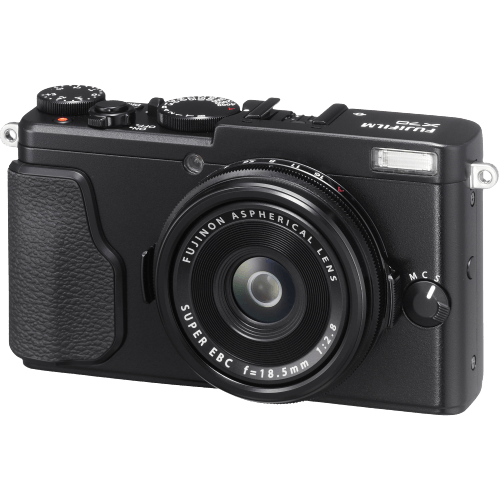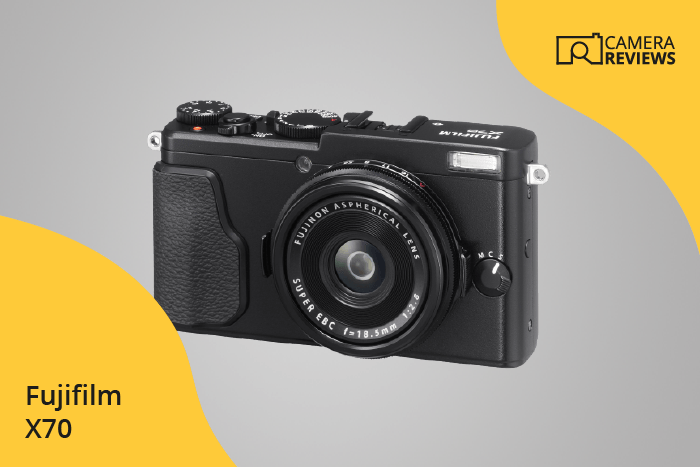Fujifilm X70 Specs and Scores

The Fujifilm X70 scores a 53 out of 100 in our evaluation. This compact camera, announced on 06/01/2016 and released in the same year, had a launch price of $799. The X70 measures 113 x 64 x 44mm and weighs 340g or 0.75lbs. Despite being a few years old, the camera’s specifications still hold up reasonably well in today’s market. Its compact size and weight make it a convenient choice for travel and daily use.
Fujifilm X70 Overview and Optics
The Fujifilm X70 receives a score of 54/100 for its optics. This camera features a 16-megapixel sensor, 8 fps shooting speed, and an APS-C CMOS sensor powered by the EXR Processor II. However, it does not have a DXOMARK score as they do not evaluate Fujifilm cameras.
The X70 has a fixed lens mount, meaning that the lens cannot be changed. This may limit its versatility compared to other cameras with interchangeable lens options. Additionally, the camera lacks image stabilization, which could affect the sharpness of images in certain shooting conditions. The aspect ratio of the X70 is 3:2, which is standard for most digital cameras.
Considering these specifications, the Fujifilm X70’s optics may not be on par with other cameras on the market today. Its limitations, such as the fixed lens mount and lack of image stabilization, could make it less desirable for some photographers. However, the camera still offers decent image quality and performance for those who prioritize simplicity and a compact design.
Fujifilm X70 Video Performance
The Fujifilm X70 holds a video score of 70 out of 100. Its video capabilities include a maximum resolution of Full HD (1920 x 1080) and a frame rate of 60fps. Additionally, this camera features a built-in time-lapse functionality.
Comparing the X70’s video specifications to current market standards, it falls short of providing 4K resolution, which has become increasingly popular among camera enthusiasts. However, its 60fps frame rate offers smooth video capture, catering to users who prioritize frame rate over resolution.
Although the Fujifilm X70 does not lead the market in video capabilities, its Full HD resolution and 60fps frame rate serve as reliable features for casual videographers and those who value time-lapse functionality.
Fujifilm X70 Features and Benefits
The Fujifilm X70 scores 57/100 in the features category. It offers a 3-inch touchscreen with a resolution of 1,040,000 dots. The screen also flips, providing versatility in shooting angles. However, it lacks GPS functionality, which limits its use for geotagging photos. The camera includes Wi-Fi connectivity, allowing easy transfer of images, but it does not have Bluetooth capabilities.
In today’s market, the X70’s features are somewhat lacking compared to newer models. The absence of GPS and Bluetooth may deter some buyers. Nevertheless, the touchscreen and flip screen provide added convenience and flexibility for users. When considering the Fujifilm X70, potential buyers should weigh its features against their specific needs and preferences.
Fujifilm X70 Storage and Battery
The Fujifilm X70’s storage and battery capabilities score 21/100. The camera has one memory card slot, accepting SD, SDHC, and SDXC cards. However, its battery life is limited to 330 shots, using an NP-95 battery type. Additionally, this camera lacks USB charging.
Compared to modern cameras, the X70’s storage and battery specifications fall short. The limited battery life and absence of USB charging can hinder long photography sessions. Despite these shortcomings, the camera remains functional for casual use and shorter shoots.
Fujifilm X70 Alternatives
Do you want to know how the Fujifilm X70 compares to its competitors? Have a look at the most popular comparisons for this camera below:
- Fujifilm X70 vs Nikon D7200
- Fujifilm X100F vs X70
- Fujifilm X-T5 vs X70
- Fujifilm X-E4 vs X70
- Fujifilm X70 vs Sony a6400
- Canon EOS 5D Mark IV vs Fujifilm X70
Fujifilm X70 FAQ
Does the Fujifilm X70 Have Built-in Image Stabilization?
Unfortunately, the Fujifilm X70 does not have built-in image stabilization. This means that you may need to use a tripod or other stabilization methods to minimize camera shake in certain situations.
Does the Fujifilm X70 Support 4K Video Recording?
The Fujifilm X70 does not support 4K video recording. Its maximum video resolution is Full HD, which is 1920×1080 pixels at 60fps.
What Size Sensor Does The Fujifilm X70 Have?
The Fujifilm X70 is equipped with an APS-C sized sensor, which is a popular sensor size for many mirrorless and DSLR cameras, offering good image quality and low-light performance.
Does the Fujifilm X70 Have a Dual Memory Card Slot?
The Fujifilm X70 features a single memory card slot, which supports SD, SDHC, and SDXC cards. This means you’ll need to swap out cards if you run out of storage during a shoot.
Does the Fujifilm X70 Have a Touch Screen?
Yes, the Fujifilm X70 has a touch screen, making it easy to navigate menus, change settings, and focus on subjects with a simple tap.
Does the Fujifilm X70 Have Wi-Fi and Bluetooth?
The Fujifilm X70 comes with built-in Wi-Fi for easy image transfer and remote control, but it does not have Bluetooth connectivity.
Does the Fujifilm X70 Have GPS?
No, the Fujifilm X70 does not have built-in GPS functionality. You will need to use an external device or smartphone app to geotag your images if desired.
Is the Fujifilm X70 Weather Sealed?
The Fujifilm X70 is not weather sealed, so you need to exercise caution when using it in harsh weather conditions or environments with dust and moisture.
Does the Fujifilm X70 Have a Built-in Flash?
Yes, the Fujifilm X70 features a built-in flash, which is useful for providing fill light or illuminating subjects in low-light situations.

